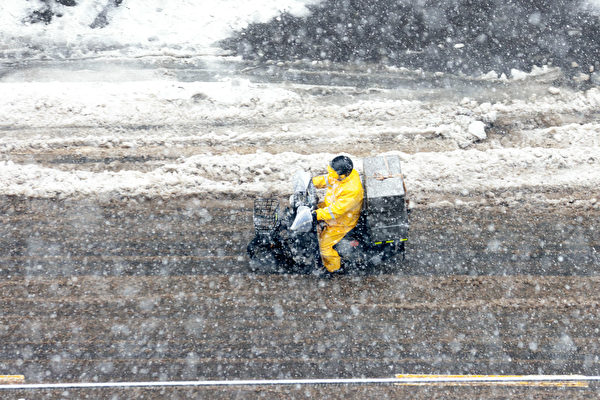China’s economy is currently facing a series of setbacks, from the prolonged real estate crisis to weak domestic demand, resulting in a heavy blow to the livelihoods of delivery riders. Explosive conflicts erupting on social media one after another indicate that these individuals are on the brink of collapse.
CNN has compiled three widely circulated conflicts involving delivery riders on social media. In one incident, a delivery rider lost control and threw his phone onto the sidewalk after receiving a negative review from a customer. Another rider knelt to apologize to a police officer for running a red light, then stood up and forcefully knocked down the officer’s motorcycle, disregarding traffic conditions to rush across the road. In another event, a group of angry drivers gathered outside an apartment building demanding justice for a delivery rider allegedly bullied by security guards, and so on.
There are approximately 12 million drivers serving as delivery riders in China’s online food delivery networks. According to data from the China New Employment Research Center, in 2018, delivery riders earned an average of over $1,000 per month, but by 2023, their monthly income had decreased to less than $950.
“They work long hours and are truly under pressure,” said Jenny Chan, Associate Professor of Sociology at the Hong Kong Polytechnic University, to CNN. “They will continue to face pressure because the platforms need to keep costs low.”
The economic downturn in China means that people are likely to order cheaper meals. Professor Chan stated that worker incomes would decrease, as most rely on commissions, forcing them to extend working hours to maintain their earnings.
Lu Sihang, aged 20, told CNN that he works 10 hours a day, making 30 deliveries daily, earning roughly $30 to $40 per shift. Based on this wage scale, he has to work nearly every day to reach the monthly average income of $950.
Currently, delivery riders are under immense pressure to complete tasks within tight deadlines, leading them to overspeed or run red lights, posing risks to their own safety and that of other road users.
The article titled “Delivery Riders Trapped in the System,” went viral on September 8, 2020. It discussed how the algorithms and data-driven nature of delivery systems have driven riders to exhaustion, resulting in violations of traffic rules and a dangerous race against time, making delivery riders a high-risk profession.
The delivery rider mentioned earlier, who smashed his phone, insisted in a Communist Party media interview that the complaints against him were baseless. However, he claimed that he still faced reduced tasks, which eroded his income.
“What do they want from me? Do they want me to die?” he said in a video.
Professor Chan told CNN that another issue is that delivery drivers are seen as freelancers paid per trip, rather than receiving monthly salaries. This causes them to ignore dangerous road conditions and prioritize making as many deliveries as possible.
“If they could deliver safely, who would run red lights? But they can’t afford to,” she stated.
Gary Ng, an economist at Natixis, mentioned to CNN that the main cause of these issues is China’s “downgrading consumption.” As the Chinese economy slows down, consumer spending decreases. He noted that although food is a necessity, economic weakness leads to reduced spending on delivery orders, forcing restaurants to lower prices to attract customers.
As a result, delivery riders’ incomes have been eroded, as their wages are usually linked to commissions based on order prices. When customers are financially constrained, they are also less likely to tip.
Meanwhile, the economic downturn means fewer job opportunities and increased competition. The Communist authorities reported that the youth unemployment rate surged to 18.8% in August (given the Communist Party’s history of falsifying data, the actual situation may be more severe). In the face of employment difficulties, delivery riders, couriers, and ride-hailing drivers are seen as the last resort for many young people to alleviate survival pressure.
“If you have a large number of employees, their bargaining power will decrease. At the same time, they can only share a limited number of delivery orders among themselves,” Ng said.
According to Meituan, a Chinese delivery platform, their “2022 Meituan Rider Rights Protection Social Responsibility Report” revealed that in 2022, over 6.24 million delivery riders worked for Meituan, an increase of nearly one million people compared to 2021.
Furthermore, labor rights observers pointed out that the dominant market position of the two major delivery platforms allows them to dictate contract terms, leaving workers with little room to protest against deteriorating working conditions.

